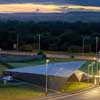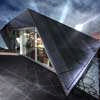Fighter Jet Building Lancashire, Reception Building, Samlesbury Design Project, Image
Fighter Jet Building, Samlesbury
BAE Systems Development, Samlesbury, South Ribble, Lancashire, England, UK – design by Capita Symonds
15 Jul 2009
Fighter Jet Building Samlesbury
BAE UNVEILS NEW ‘FIGHTER JET’ RECEPTION BUILDING
Architect: Capita Symonds
Fighter Jet Building in Samlesbury, Lancashire
Featuring a design inspired by the dynamic form of a Fighter Jet, the spectacular new reception building at BAE Systems’ manufacturing and aerospace facility at Samlesbury in Lancashire has officially opened.
The facility – which employs over 4000 people – is responsible for building the front fuselage and other parts of the Eurofighter Typhoon as well as a number of other aircraft including the Lockhead Martin F-35 Lightning II.


Fighter Jet Building photos : BAE
Two major new four-storey office buildings, which have achieved a minimum BREEAM rating of ‘Very Good’, have also opened at the site. The buildings will accommodate flexible engineering accommodation – one will house F35 staff while the other will house customer support for BAE’s Saudi Contracts.
The offices feature a raft of sustainable features including low energy consumption, biomass boilers, rainwater harvesting and a central atrium providing both a wealth of natural daylight and air circulation. As part of the green travel plan, showering and changing facilities have also been provided within the office buildings to encourage staff to cycle into work and help cut down the company’s carbon footprint.
The new reception building and offices are major milestones in the wider redevelopment of the Samlesbury site which also comprises site wide infrastructure including a new site entrance, on site roads and landscaping, as well as a new F35 machining facility.
Capita Symonds has been providing architectural, masterplanning, design, structural engineering and M&E services on the projects since 2004.
BAM Construction is the contractor on the projects and is also delivering office and machining facilities at the Samlesbury site. Ian Fleming Construction Director for BAM said: “As design and construct contractor, it gives us immense pride to handover these ‘state-of-the-art’ office buildings to an exacting client like BAE Systems. The BAE team and BAM teams have been working closely together for over two years to ultimately deliver a superb facility that is well equipped to serve the needs of aircraft designers.”
The ‘Fighter Jet’
Capita Symonds’ architectural team stayed true to their ‘Fighter Jet’ concept (originally etched on a post-it note) from day one. As Altaf Master, Lead Designer, Capita Symonds, explains: “The original concept was for a traditional brick building and site feature entrance. However, we pitched a striking idea which alludes to the dynamic form of a fighter jet – reflecting the site’s role as the home of advanced aerospace manufacturing while doubling both as a functional facility and a striking site feature.”
“We also received invaluable support from the Structural Engineering team in overcoming huge technical issues to produce an innovative design that features a dramatic structure with rainscreen cladding on external walls and roof to give it a seamless skin,” he adds.
Dave Holmes, Director of Investment and Infrastructure Services, BAE Systems, said, “This marks another significant milestone in the transformation project. The new reception facility and improved entrance are designed to create the right image for Samlesbury site and the business, whilst at the same time being highly functional.”
The building was conceived as a folding surface and is articulated by cladding the external roof and wall elements in the same cladding material. Contemporary detailing ensures seamless integration of wall, roof and floor elements, thereby further strengthening the concept. The remaining elements of the external skin are also enclosed by a transparent glazed curtain walling system
Positioned to make it clearly visible from the nearby A59, the building also benefits from a new wind turbine which has been installed as part of the site wide infrastructure to provide up to 10% renewable energy.
In terms of structural engineering, Paul Savile explains: “With the concept set, work began defining the structural geometry to support such a dynamic contemporary building. It was clear from the outset that the use of a steel framework with moment connections would be required. In order to deliver the necessary global and torsional stability a folded envelope of triangulated hollow steel sections was used.”
“With such a geometrical puzzle to solve, our structural engineering model was central to establishing space and ensuring that all disciplines accurately understood how the form and layout changed around the building, and the implications of those variations on structure, architecture and building services,” he adds.
The Office Buildings
The office buildings – 608 and 609 – are the first two of four ‘pavilion’ buildings envisaged in the brief. The buildings are all generally equal in size, shape and capacity and have been developed to allow flexibility in use and subsequent future proofing of each functional tier (the phased development should be able to work together with the future phases, while at the same time being able to stand alone before the following phases are built, or should further phases not proceed).
The key element linking the proposed phases is the atrium, with bridge links at each floor level for connection into future phases. This is envisaged as a dynamic form which creates vistas and surprises rather than a linear tunnel. The form allows views along the whole length of the series of buildings while providing glimpses into the working and meeting spaces in each building, at each level. In the case of an individual building or phase the concept still pertains, the movement of the form provides views, and encourages interaction. The East and West elevations are solid planes interrupted by the Atrium which breaks through the centre, and windows are punched, recessed openings, small and relating purely to the functional space behind them.
Each four storey building consists of two 52.5m x 18m rectangular floor plates, broken by the 10.5m wide atrium space, post-tensioned concrete floor slabs are being provided with exposed fair faced soffits. The floor zoning has been arranged so that ‘fixed’ service and circulation cores are situated around the outside edges of the building thus leaving maximum flexibility to the open plan office floor plate.
Other key features include:
– A groundbreaking active multi-service beam solution to provide low energy consumption and low maintenance;
– 18 m office depth with daylighting to both sides;
– Minimum BREEAM rating of ‘Very Good’;
– Independent energy prediction calculations that show a 30% improvement on the Building Regulation requirements;
– Exposed concrete slabs allowing “Free Night Time Cooling” of the building (this works on the basis of using ‘free’ cool night time air to purge the concrete structure of heat, thereby reducing the amount of mechanical cooling needed the next day and, in turn, reducing energy consumption;
– Solar Treatment including high specification glazing and solar shading to reduce heat gain;
– Biomass Boilers that provide a carbon neutral means of heating the building in winter;
– Rainwater Harvesting facilities to reduce the buildings’ requirement for mains cold water;
– Sophisticated Lighting controls to reduce artificial lighting when daylight is available;
Fighter Jet Building images / information from Capita Symonds 150709
Location: Samlesbury, South Ribble, Lancashire, England, UK
Architecture in England
Contemporary Architecture in England
About Capita Symonds
Capita Symonds is one of the UK’s largest and most diverse multidisciplinary consultancies operating in the building design, civil engineering, environment, management and transport sectors. With over 4,000 staff in over 50 UK offices we offer an unrivalled scope of services and a unique blend of professional and technical skills to schemes of all types and complexities.
Lancashire Buildings – selection:
Avenham Park Pavilion, Preston
McChesney Architects
Avenham Park Pavilion
Preston Office Building Competition
Moxon Architects
Preston Office
Chatsworth Gardens, Morecombe
Peter Barber Architects
Lancashire housing
Comments / photos for the Fighter Jet Building England Architecture page welcome
